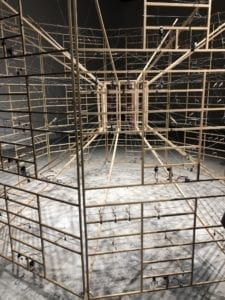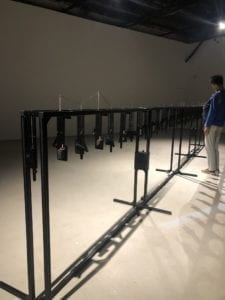Chronus Exhibition
When we visited the Chronus Exhibition we saw several technology-based artworks. One of the projects used several arduinos as well as other things we used from our arduino kits. I was next to several of the fellows talking about it and learned from that too. Some of the conversations were about how it was not using a loop but somehow every part was working independently so they output would be different every time. There were so many different parts that all came together and the thought that had to go into it seems unthinkable. It was also very cool to see everything that we have been working on in class in a real museum. I think that because of this I had a better understanding of it than I would have without having learned it in class. I also appreciated it more than if I were at a regular art museum. This exhibit had so many different things so look at and kept the viewer curious as to how it functioned, even the fellows and professors.

This project I was a bit confused about. I think because of my previous visits to art museums I was looking for something different. I was trying to find a meaning out of it, but when I read the plaque it wasn’t what I was expecting. Not going to lie I thought it was a bridge at first, but because it was based around technology I understand why it was made to represent something different. It wasn’t very interactive with the user but when I did read about it I realized it was meant to represent a constant journey to perfection with each piece working individually to find it’s ideal hight.

Research
When doing my research, I found one a project called “Guitar Pedals,” that uses steps to make the sounds a guitar would but gives users who haven’t even learned how to play the ability to make 96 different sounds that would be incredibly hard to do otherwise. I think that this project did a very good job of being interactive. It makes every person’s experience with it different by giving them the ability to make something nobody else has before. It gives them the freedom to be creative. The user presses one of the pedals and the project takes in that data and plays the corresponding sound. The sounds can play together which makes it unique because I remember coming across that when doing the midterm project. I had several different songs, but they were already set melodies and could not interrupt each other.
Guitar Pedals, An Interactive Art Installation of 96 Guitar Effects Pedals by David Byrne
The next project I researched was part of “The Happy Show” at MOCA. The project has several tubes with marbles and has a question at the bottom that reads “how happy are you?” Each visitor is prompted to take one of the marbles from the tube that most represents how they feel. I think that there are up and downsides to this project. On the one hand, it attracts and allows users to interact with the project while collecting data which is very smart. The users can see the data unfold as the day goes on. On the other hand, there isn’t that much that goes into it. There isn’t an instant gratification the user gets from the project. It takes time and cannot be fully experienced while they are there in front of it. It isn’t portable so it makes it hard for them to really see how they’ve affected it.

After doing research, I think that one thing I learned that adds to my definition of interaction is that, yes, there is an input and output that depend on each other, but the experience of the user is also important. It goes back to the question we asked at the beginning of the semester, “is opening a refrigerator and light turning on considered interactive?” I still believe that there are different levels of interactivity, but to be successful you need to be engaging and provide some sort of incentivizing factor. In Bret Victor’s article, A Brief Rant on the Future of Interactive Design, he says that “if a tool isn’t designed to be used by a person, it can’t be a very good tool, right?” He brings up a valid question that is why would we interact with something that is not necessary to us in the first place? Successful interactivity should be engaging and productive at the same time.
http://worrydream.com/ABriefRantOnTheFutureOfInteractionDesign/
minimallyminimal.com/blog/the-happy-show-at-moca